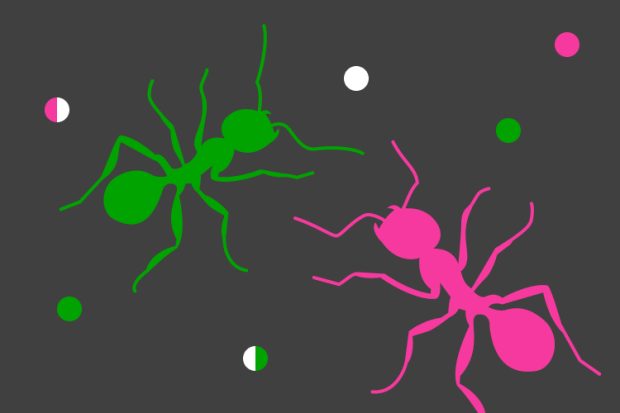Developmental Mechanisms of Evolutionary Change
Biologist Arkhat Abzhanov on principal component analysis, molecular-based phylogenetic tree, and zebrafish em...
If some biologists talk about biological altruism, what they mean is behaviour that we see in the natural world where an animal seems to be hurting its own chances of reproducing in such a way to confer a benefit on another animal so that the other animal seems to have its chances of reproducing increased because of the costs being paid by this altruist.

Perhaps the best-known examples are ants. Ants are fantastically social creatures. In the most complex social species, so-called eusocial species, there are the queens, and there are the workers, and the entire lives of the workers, their entire developmental process, all of their behaviour is really dedicated to raising the larvae of the queen, so they’re not raising their own offspring at all: they’re helping to raise another organism’s offspring, the queen’s offspring. In ants, this is taken to spectacular extremes: there are some ants that the workers become living honey pots, basically where all they do is hang upside down inside the nests from the ceiling and store a huge amount of liquid food in their bodies for the larvae to feed off. Their whole life is just spent as a kind of living food store. Incredible self-sacrifice, it would appear, by those ants.
There are other species where the ants live in a nest, and at the end of the day, when nightfall comes, there’s a risk of predators attacking the nest overnight. So these ants seal the nest from the outside, and they’re stuck outside, they can’t get back in, and they die in the night because it’s so cold. But the rest of the colony inside the nest gets to survive. So those ants have stayed out in the cold to sacrifice their lives, it would seem, so that the rest of the colony can survive.
These examples are biologically altruistic, but that doesn’t necessarily mean that there’s anything psychological going on; it doesn’t mean that the ant is genuinely motivated by concern for the other ants.
All we’re saying when we say it’s biologically altruistic is that the behaviour really hurts the chances of reproduction of one ant and confers a real material benefit to the chances of reproduction for another.
And this kind of biological altruism we see all over the natural world: we even see it among single-celled microorganisms.
I think one of my absolute favourite examples of biological altruism is in amoebas. It’s in an amoeba called Dictyostelium discoideum. For most of their lifecycle, these amoebas are just like what we think of amoebas, just single-celled organisms living in the soil. But when food gets scarce, what they do is they detect how many other amoebas there are around them in their environment, and if they detect there’s a lot of other amoebas close to them, they aggregate into a single slug-like thing often called grex or a pseudoplasmodium, a kind of mobile slug, and then they move as one in the direction of heat and light. It really looks like a slug; it really looks like these amoebas have got together tens of thousands of them, and they formed a multicellular organism. It’s incredible. But then, when they actually get to a suitable place, they do something even more amazing, which is that they form a fruiting body where about a fifth of the amoebas basically sacrifice their lives to form a hard stalk, so 20% of them die, they form this hard stalk so that the other 80% can climb up the stalk and gather at the top and produce spores, and those spores drift through the air, and they land somewhere where, hopefully, there’s a bit more heat and light and food than where these amoebas found themselves.
I think the answer to this question was basically discovered by a scientist called Bill Hamilton in the ’60s. He was a graduate student based in London, based at UCL Galton Laboratory, and also at LSE. He just had in the early 60s this incredibly seminal idea, drawing inspiration from two main sources. First is Ronald Aylmer Fisher. Fisher is really one of the architects of evolutionary biology as we know it, a great genius who founded the field of population genetics. In one of his books, The Genetical Theory of Natural Selection, Fisher just made this kind of throwaway remark that isn’t it kind of weird that insects are really distasteful to predators in some species? Because the insect doesn’t really gain anything by being distasteful because it’s dead by the time it’s in the predator’s mouth. It doesn’t really gain anything by being distasteful. And then Fisher says, oh well, it doesn’t benefit itself, but it benefits its siblings because that predator will be less likely to eat the siblings of this insect that it’s just eaten and found really unpleasant. Fisher says, well, of course, there’s an evolutionary incentive there, although it’s only half as great, he says, as if the insect itself survived.
The other key influence on Hamilton was John Burdon Sanderson Haldane, another key architect of what we call the modern synthesis, modern evolutionary biology as we know it. There’s a story about Haldane that may or may not be true, but I think is probably true. He was in a pub one day, a short distance from here, near UCL, called ‘The Orange Tree’, drinking with his graduate students, one of whom was John Maynard Smith himself, who went on to become a great evolutionary biologist. And someone asked him, what would it take in evolutionary terms to give you an incentive to jump into a river to save a drowning stranger? The story is that Haldane sat and calculated on the back of an envelope for a few minutes and came up with this quip that I’ll jump into the river to save two brothers or eight cousins.
The thought here is that even under a ruthless Darwinian process of natural selection actually organisms have an incentive to help one another sometimes, they have an incentive to help their genetic relatives, and the incentive to help is proportional in some sense so the closeness of the genetic relationship.
So, your evolutionary incentive to help your brothers and sisters is greater than your evolutionary incentive to help your cousins.
What Hamilton did pretty much independently of Haldane was he really took this insight originally from Fisher and developed it into a rigorous theory, a really powerful mathematical theory that’s now usually called inclusive fitness theory. He showed that the basic insight of Fisher and Haldane can actually be captured in a surprisingly simple mathematical result. This is a result that’s now come to be known as Hamilton’s rule, and the rule says that altruistic behaviour is actually favoured by natural selection when a particular condition is satisfied, rB > C, where to just explain those terms, C is the magnitude of the cost paid by the altruist measured in terms of how much reproduction it sacrifices, B is the benefit that gets conferred by that behaviour on the queen, on another organism, again measured in units of reproductive success, and then r is what’s called the coefficients of relatedness, a measure of how closely these organisms resemble each other, genetically relative to two randomly picked organisms from the population.
A lot of debates have ensued in the past 50 years about whether Hamilton was right or not, whether this rule is right or not. A large part of my book, The Philosophy of Social Evolution, is really about this debate and about the controversy that has raged about Hamilton’s ideas. A lot of people look at this rB > C rule and think, how can it possibly be so simple? How can the mathematics of altruism just boil down to this incredibly simple calculation, just this cost-benefit calculation? They think it’s too simple.
Sometimes, you can get this genetic resemblance arising without any kinship in the ordinary sense. Richard Dawkins has a nice story in his book The Selfish Gene about what he calls a green beard gene. The green beard gene has three effects: it causes the organism with the gene to grow a green beard, and it then causes that organism to go and seek out other individuals in the population who also have green beards, and then it causes the individual to behave altruistically to those individuals with the green beards. So it’s causing this altruism. The altruism is not necessarily directed towards close relatives: it’s directed towards other organisms with green beards, but Dawkins argues that’s still enough; such a gene can spread by natural selection. The reason it can spread is that the benefits of the altruism produced by the green beard gene tend to fall on other organisms with that same gene, other organisms with the green beard. That’s actually the way we should think about relatedness: not as requiring kinship in the intuitive sense but just requiring that at relevant points in the genome, organisms share the same genes.
This rB > C rule, really, what it’s giving us is a snapshot of a really complex evolutionary process. The fact that it’s satisfied at one moment doesn’t necessarily guarantee that it will be satisfied the next moment. Also, you should think of this not as providing the complete story, a complete explanation of why altruism exists in the natural world, but rather a kind of organizing framework in which we can then mount further investigations of the sort of actual ecological processes that can create positive r or that can create positive B or that can help offset the cost to the altruist. So, really, it’s the starting point for further investigation of the real natural phenomena rather than this kind of grand explanation that just explains everything. Nevertheless, I think Hamilton basically gave us the answer: he explained how altruistic behaviour can be reconciled with Darwinian logic.

Biologist Arkhat Abzhanov on principal component analysis, molecular-based phylogenetic tree, and zebrafish em...

Geneticist David Sinclair on the aging dogma, SIR proteins, and an efficient way of DNA repair

Geneticist George Busby on mutations, African and European genomes, and genetic markers